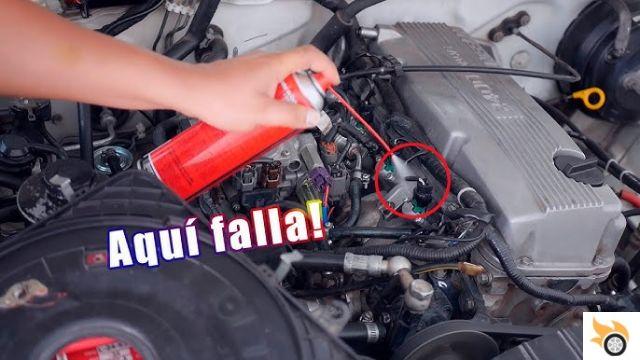
Introduction
Welcome to Pistonudos.com, where we are dedicated to providing information and advice on everything related to the automotive world. In this article, we'll cover air leaks in a car's intake system and engine, as well as how to detect intake manifold malfunctions and engine compression problems. In addition, we will provide you with information on the symptoms of a vacuum leak and how to detect a lack of compression in the engine. Read on for all the details!
How to diagnose and repair air leaks in the intake system?
Air leaks in the intake system can cause a number of engine performance problems. To diagnose and repair these leaks, follow the steps below:
Step 1: Visually inspect the intake system
Begin by visually inspecting the intake system for any signs of damage or wear. Look for cracks, loose or broken clamps, cracked or disconnected hoses, and any other signs of air leaks.
Step 2: Use an air leak detector
If you can't find any leaks visually, you can use an air leak detector. This device uses smoke or special fluid to identify leaks in the intake system. Follow the manufacturer's instructions for proper use of the detector and for locating leaks.
Step 3: Fix the leaks
Once you've identified leaks, it's important to fix them immediately. Depending on the type of leak, you may need to replace a hose, tighten a clamp, or seal a crack. If you don't feel comfortable doing these repairs yourself, we recommend going to a professional mechanic.
How to detect anomalies in the intake manifold?
The intake manifold is a crucial part of an engine's intake system. If there is any abnormality in the manifold, it can affect the performance of the engine. Here's how to spot these anomalies:
Listen for any unusual noise
If you hear an unusual noise coming from the intake manifold, such as hissing or hissing, this may indicate an air leak. Pay attention to any changes in engine sound, and if you spot anything out of the ordinary, it's a good idea to get it checked out right away.
Perform a visual inspection
Visually inspect the intake manifold for cracks, dents, or any other visible damage. If you find anything abnormal, it's important to repair or replace the intake manifold as soon as possible.
Check intake manifold pressure
Use a pressure gauge to measure intake manifold pressure. If the pressure is too low or too high, it may indicate a manifold problem. Consult the manufacturer's manual for the recommended pressure values and compare them with your measurements.
How to detect compression problems in the engine?
Compression is vital to proper engine operation. If there are compression issues, it's important to detect and fix them as soon as possible. Here we show you how to do it:
Perform a compression test
Use a compression gauge to perform a test on each cylinder of the engine. Follow the manufacturer's instructions to properly perform the test. If the compression reading is low in one or more cylinders, it may indicate a compression problem.
Check the condition of the spark plugs
Worn or bad spark plugs can affect engine compression. Remove the spark plugs and check their condition. If they are dirty, worn or damaged, it is advisable to replace them.
Inspect the piston rings
The piston rings are responsible for sealing the cylinders and maintaining compression. If the rings are worn or damaged, they can cause a loss of compression. Visually inspect the rings and, if necessary, replace them.
Frequently Asked Questions (FAQs)
1. What are the symptoms of an engine vacuum leak?
Symptoms of an engine vacuum leak can include rough idling, decreased engine power, difficulty starting the engine, and increased fuel consumption. If you experience any of these symptoms, it is recommended that you check the intake system for vacuum leaks.
2. How can I detect a lack of compression in the engine?
A lack of compression in the engine can manifest itself through a loss of power, difficulty starting the engine, rough idling, and increased oil consumption. If you suspect a lack of compression, we recommend running a compression test to confirm the problem.
3. Can I fix air leaks and compression problems myself?
If you have knowledge and experience in auto mechanics, you may be able to perform some repairs yourself. However, it is important to note that working on the intake system and engine can be complicated and require specific tools. If you do not feel confident or do not have experience, it is advisable to go to a professional mechanic to carry out the necessary repairs.
Conclusion
In short, air leaks in a car's intake system and engine can cause engine performance problems. It is important to diagnose and repair these leaks in a timely manner to prevent further damage. In addition, abnormalities in the intake manifold and compression problems can also affect the operation of the engine. If you detect any symptoms of a vacuum leak or lack of compression, we recommend that you see a professional mechanic for a proper evaluation and any necessary repairs.
We hope this article has been useful and has provided you with the information you were looking for. If you have any additional questions or want to share your experience, feel free to leave us a comment below. We will be happy to help you!
Until next time at Pistonudos.com!


























